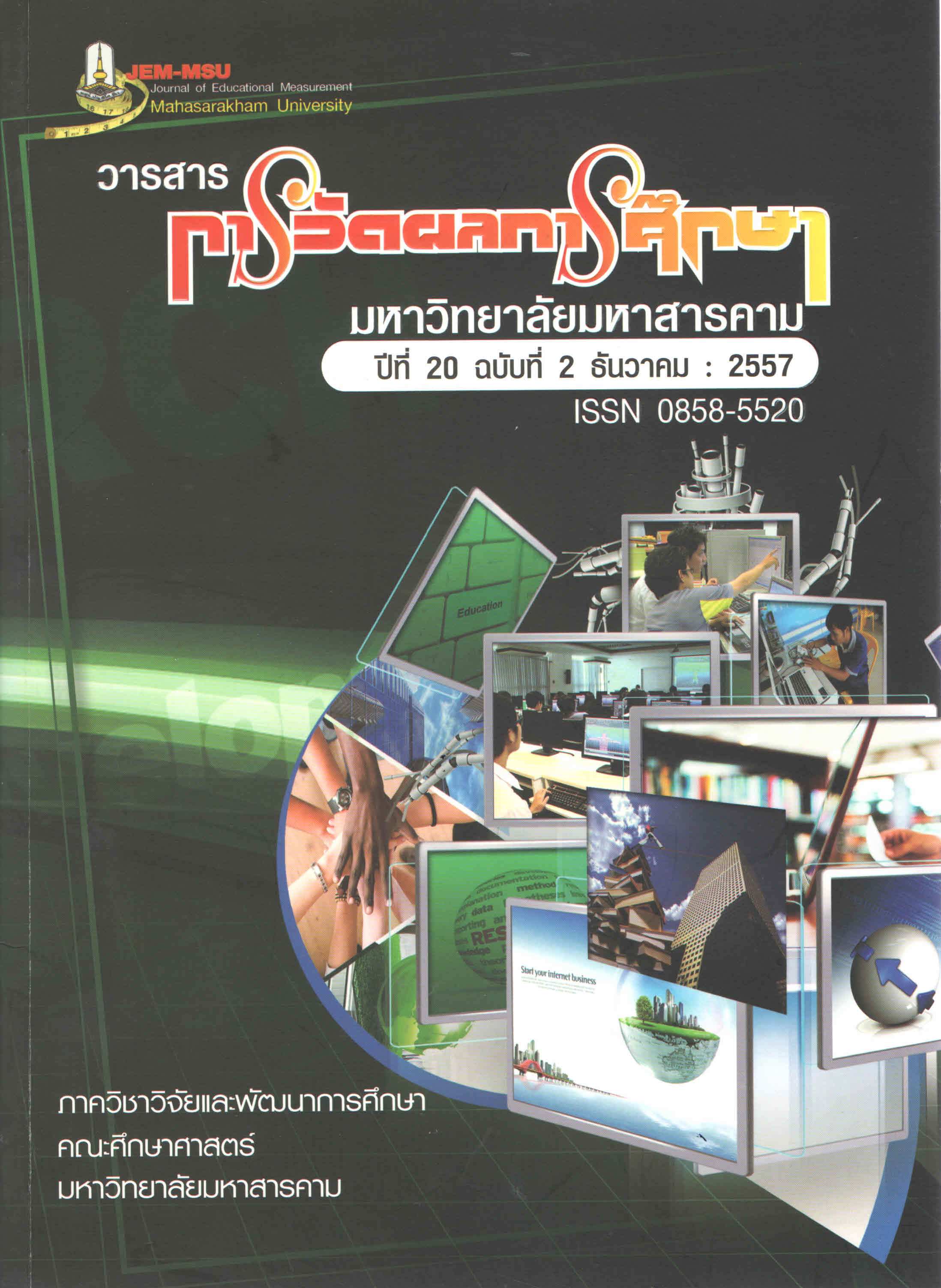The Model of Multi-Level Factor Structural Equation Affecting Thai Learning Achievement of Prathomsueksa 6 Students in Changwat Nakhon Ratchasima
Main Article Content
Abstract
The current found : Learning achievement and academic abilities should
be implanted the students, which has been developed not yet target the purposes
of Education Act. Especially the Thai teaching quality. Thus the purposes of this
study were to : 1) analyze confirmatory factor affecting of Thai learning
achievement of Prathomsueksa 6 students, and 2) develop and check a
construct validity of the model of multi-level of structural equation, influences
of teaching style and factor affecting of Thai learning achievement of
Prathomsueksa 6 students. The sample consisted of 785 Prathomsueksa 6
students and 72 Thai teachers under The Office of Nakhon Ratchasima
Primary Educational Service Area in the first Remester of the academic
year of 2011, obtained using the muti-stage random sampling technique.
The instruments used in the study were : an achievement test with
difficulties (p) 0.24 - 0.80, with discriminating powers (r) ranging 0.20 - 0.72,
and a reliability (KR-20) of 0.920 ; a scale on altitude toward learning ;
and a scale on achievement motivation with discriminating powers (rxy)
ranging 0.26 - 0.79 and 0.24 - 0.85 respectively and reliabilities (a) of 0.87 and
0.93 respectively a questionnaire on classroom climate with discriminating
powers (rxy) ranging 0.35 - 0.75 and 0.43 - 0.74 respectively, and reliabilities
(a) of 0.90. The collected data were analyzed using descriptive statistics,
multiple correlation for coefficient analysis, confirmatory factor analysis,
multi-level confirmatory factor analysis, structural equation model analysis,
and multi-level structural equation model analysis.
The study findings could be summarized as follows :
1. The result of analyzing confirmatory factors of SIt teaching style
reviewed that there was construct validly or congruence with the empirical
data. This could be considered from statistical values used for checking and
the model validity including : 2 = 1.868, df = 4, p = 0.7601, CFI = 1.000, TLI=
1.071, RMSEA = 0.000, SRMRW = 0.007, SRMRB = 0.038 and 2 /df = 0.467. All of the
noticeable valiables could be had in class correlation (ICC) since 0.110 to 0.274,
showing that the noticeable valiables had to have variance at the student and
classroom levels to be appropriate to use for are analyzing multi-levels.
2. For the results of developing and checking validity of the model
of multi-level factor structural equation and influences of the factor affecting
Thai leaning achievement of Prathomsueksa 6 students, it was found that the
model was in congruence with empirical data. This could be considered
from statistical values used for checking and the model validity including :
2
= 257.483, df = 225, p = 0.0676, CFI = 0.992, TLI = 0.991, RMSEA = 0.014,
SRMRW = 0.024, SRMRB = 0.292 and 2 /df = 1.14. The variables at the students
level direct affecting Thai learning achievement were : Attitude toward Learning
and prior knowledge with effect sizes of 0.238 and 0.948 respectively. The
variables at the students level indirect affecting Thai learning achievement
were : Achievement motivation by passing Attitude toward Learning and prior
knowledge with effect sizes of 0.864 and 0.475 respectively. The variables at the
classroom level direct affecting Thai learning achievement were : classroom climate
with effect sizes of 0.833 but SIt teaching style not affected Thai learning
achievement. All of the predictive variables at the students level and the
classroom level could cooperatively predict learning achievement (r2 ) at 97.9
and 50.8 percent respectively.
In conclusion, the study findings indicated that most of the variables
direct influence on learning achievement of prathomsueksa 6 students at the
student level included Attitude toward Learning and prior knowledge. The
variables at the students level indirect affecting Thai learning achievement
included Achievement motivation by passing Attitude toward Learning and
prior knowledge, while at classroom level including classroom climate.
Therefore, parents, teachers and those involved should promote, support
and determine a guideline for developing the factors as mentioned which
would also increase Thai learning achievement.
Article Details
The content and information contained in the published article in the Journal of Educational Measurement Mahasarakham University represent the opinions and responsibilities of the authors directly. The editorial board of the journal is not necessarily in agreement with or responsible for any of the content.
The articles, data, content, images, etc. that have been published in the Journal of Educational Measurement Mahasarakham University are copyrighted by the journal. If any individual or organization wishes to reproduce or perform any actions involving the entirety or any part of the content, they must obtain written permission from the Journal of Educational Measurement Mahasarakham University.

